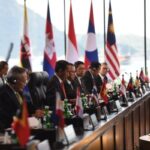
CHINA’S BELT AND ROAD INITIATIVE (BRI) IN MYANMAR
Overview
Launched by China in 2013, the Belt and Road Initiative (BRI) is a global development strategy focused on improving regional connectivity and economic integration through large-scale infrastructure projects. Myanmar holds a strategic position in the BRI as a crucial land bridge linking China to the Indian Ocean, making it a key partner in this initiative.
Key Projects in Myanmar
1. China-Myanmar Economic Corridor (CMEC)
The CMEC is a flagship BRI project designed to connect China’s Yunnan Province with Myanmar’s western coast. The corridor follows the route: Kunming → Mandalay → Yangon → Kyaukphyu, opening a vital passage to the Indian Ocean and boosting trade and logistics in the region.
2. Kyaukphyu Deep-Sea Port
This deep-sea port is a central component of the CMEC, providing China with strategic access to the Indian Ocean. It supports oil and gas pipelines that help China bypass the congested and vulnerable Strait of Malacca.
While the port itself has not reported direct damage from the 2025 earthquake, the region has experienced infrastructure disruptions, including the collapse of the historic Ava Bridge. This has significantly affected transportation and the movement of goods along the corridor.
3. Oil and Gas Pipelines
The pipelines running from Kyaukphyu to Yunnan have been operational since 2013–2017. They transport millions of barrels of oil and billions of cubic meters of natural gas each year, playing a critical role in China’s energy security.
4. Railways and Industrial Zones
Plans are underway to build high-speed rail links connecting Kyaukphyu, Mandalay, and eventually China. Alongside this, several special economic zones (SEZs) and industrial parks are being developed to promote industrial growth and investment.
Economic and Political Impacts
Infrastructure Boost: Roads, bridges, and ports built under the BRI have enhanced Myanmar’s trade capacity and logistics networks.
Job Creation: Investments have generated employment opportunities in construction and related sectors.
Debt Concerns: Some critics warn of potential “debt trap diplomacy,” cautioning that Myanmar’s borrowing from China may lead to financial challenges.
Geopolitical Influence: The BRI increases China’s strategic and economic influence in Myanmar, raising concerns among local communities and international observers.
Local Challenges
Environmental Issues: Large-scale infrastructure projects raise concerns about environmental degradation.
Land Rights: There have been disputes over land ownership and local resistance to certain BRI developments.
Political Instability: Ongoing military rule and internal conflict complicate project continuity and international cooperation.
Impact of the 2025 Earthquake
The devastating earthquake in March 2025 highlighted vulnerabilities in Myanmar’s infrastructure, including those linked to BRI projects. While the Kyaukphyu port remains intact, the collapse of the Ava Bridge and damage to key transportation routes have disrupted the China-Myanmar Economic Corridor. These challenges, combined with ongoing civil unrest and limited resources, may slow down infrastructure development and affect the progress of BRI projects in the near term.
Conclusion
China’s Belt and Road Initiative presents both significant opportunities and complex challenges for Myanmar. Infrastructure investments could drive economic growth and regional connectivity. However, realizing these benefits requires transparent management, respect for local communities, and stable political conditions. The 2025 earthquake has underscored the fragility of such large-scale projects in politically sensitive and disaster-prone areas. The future success of BRI in Myanmar will depend on cooperation, resilience, and sustainable development strategies.
Further Reading & References
China-Myanmar Economic Corridor – Wikipedia
Kyaukphyu Deep Sea Port – Wikipedia
2025 Myanmar Earthquake – Wikipedia
Impact of BRI in Myanmar – Geopolitical Monitor
Reuters: Myanmar Earthquake and Economic Impact
Thank you for reading! Visit us anytime at Myanmar.com for more insights and updates about Myanmar
Related posts:
 ASEAN’s Role in Myanmar’s Political Crisis: Diplomacy at a Crossroads
ASEAN’s Role in Myanmar’s Political Crisis: Diplomacy at a Crossroads
 SpaceX Cuts Starlink Access at Myanmar Scam Compounds
SpaceX Cuts Starlink Access at Myanmar Scam Compounds
 Myanmar’s earthquake death toll rises to 3,770
Myanmar’s earthquake death toll rises to 3,770
 The Earthquake Offers ASEAN a Chance to Rethink Its Humanitarian Strategy in Myanmar
The Earthquake Offers ASEAN a Chance to Rethink Its Humanitarian Strategy in Myanmar
 International Call to Free Jailed Journalist in Myanmar
International Call to Free Jailed Journalist in Myanmar
 Policy Dilemmas and Stability: Bangladesh’s Approach to the Arakan Army
Policy Dilemmas and Stability: Bangladesh’s Approach to the Arakan Army
